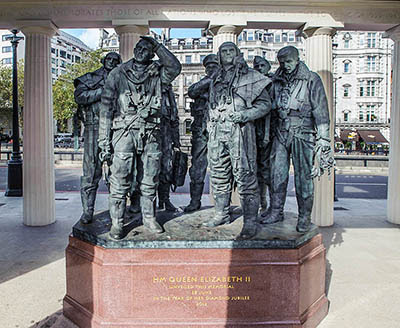April 3, 1945 - Evacuations from Wetzlar Begin
Colonel Stark, having left Wetzlar on March 31, arrived in Paris on April 3, 1945 to complain to the US Air Force Lieutenant General about the timelines for evacuating the camp. Quesada had Wetzlar air-evacuated within hours of their meeting.
Douglas Hicks, Gordon Nicol and the other liberated prisoners from Dulag Luft would be flown back to England aboard DC-3s from the nearby airfield. Hicks described the warm welcome he and the other former POWs would receive on arrival at RAF Cosford, the RAF reception and rehabilitation centre for returning prisoners of war:
En route to England we fly over the city of Cologne. I can see the devastation in the city. After crossing the Rhine, I really feel liberated. We land at an English fighter station in the south of England. The complete station staff is on hand to greet us. The station has gone to great lengths to make our arrival something to remember. They have baked cupcakes and many other types of goodies. There is a hand-lettered sign welcoming us back to England.
After a short debriefing I am allowed to send a telegram home to my mother. This is foremost in my mind, as the worrying at home can now stop. I also make a local phone call [to Mary Burton, the fiancé of Navigator David Yemen]. When I called her, she was more than elated. I could only tell her that her [fiancé], when last seen, was in good health. I also brought her up to date on the disposition of the rest of the crew. She had, on her own volition, obtained all the names and home addresses of the crew and had been in contact with all of the families. It was very difficult to tell her the names of our crew who did not make it. No doubt the burden of informing the rest of the crew families weighed heavily on her shoulders.
While it was a time of relief for Hicks and Nicol, crewmates Gerard Kelleher and David Yemen were still marching south towards Stalag Luft XIIID near Nuremburg. For Kelleher and Yemen, their liberation was still a month away.
Douglas Hicks, Gordon Nicol and the other liberated prisoners from Dulag Luft would be flown back to England aboard DC-3s from the nearby airfield. Hicks described the warm welcome he and the other former POWs would receive on arrival at RAF Cosford, the RAF reception and rehabilitation centre for returning prisoners of war:
En route to England we fly over the city of Cologne. I can see the devastation in the city. After crossing the Rhine, I really feel liberated. We land at an English fighter station in the south of England. The complete station staff is on hand to greet us. The station has gone to great lengths to make our arrival something to remember. They have baked cupcakes and many other types of goodies. There is a hand-lettered sign welcoming us back to England.
After a short debriefing I am allowed to send a telegram home to my mother. This is foremost in my mind, as the worrying at home can now stop. I also make a local phone call [to Mary Burton, the fiancé of Navigator David Yemen]. When I called her, she was more than elated. I could only tell her that her [fiancé], when last seen, was in good health. I also brought her up to date on the disposition of the rest of the crew. She had, on her own volition, obtained all the names and home addresses of the crew and had been in contact with all of the families. It was very difficult to tell her the names of our crew who did not make it. No doubt the burden of informing the rest of the crew families weighed heavily on her shoulders.
While it was a time of relief for Hicks and Nicol, crewmates Gerard Kelleher and David Yemen were still marching south towards Stalag Luft XIIID near Nuremburg. For Kelleher and Yemen, their liberation was still a month away.

Comments
Post a Comment